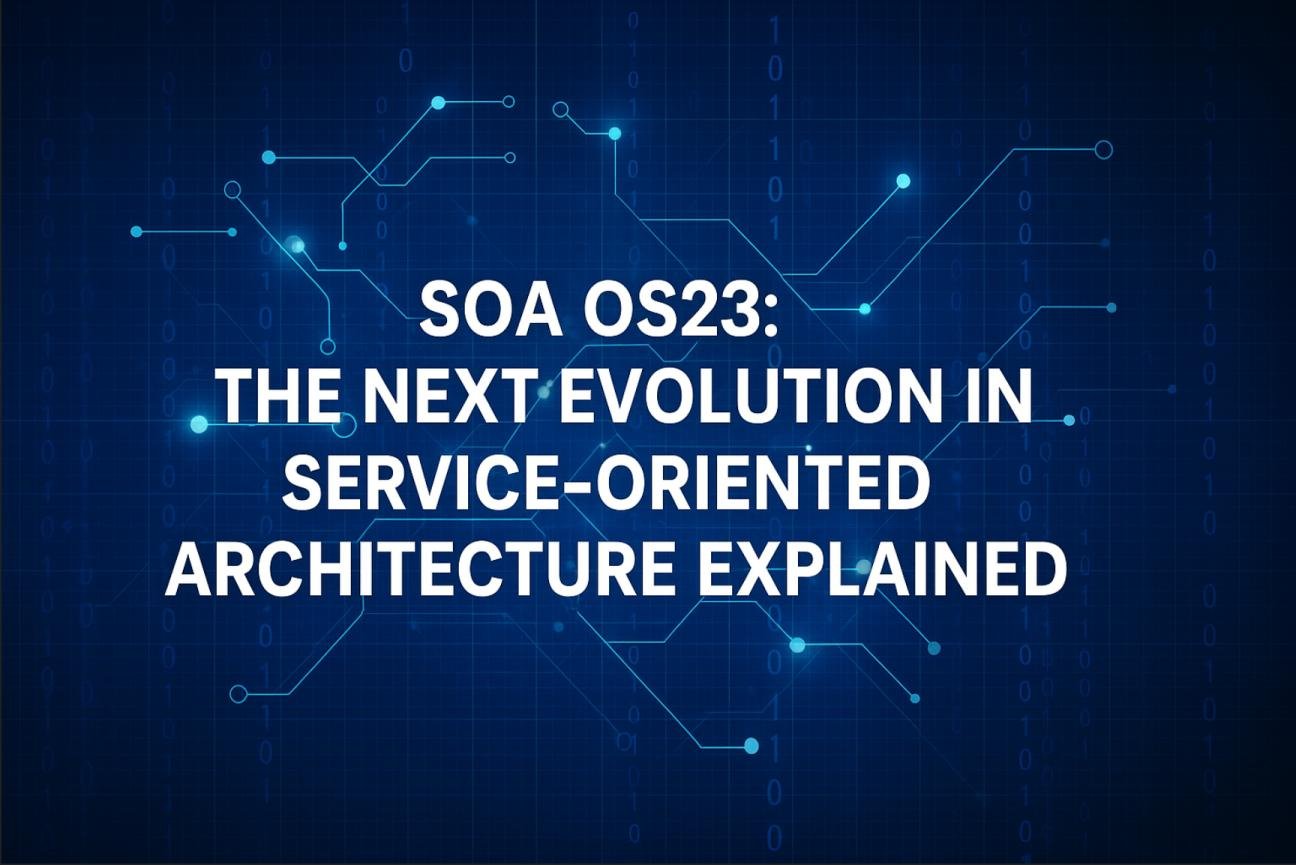Let’s talk about SOA OS23.
If you’re into tech infrastructure, enterprise architecture, or anything that touches distributed systems and digital services, then you’ve probably come across the term SOA — Service-Oriented Architecture. But what happens when SOA gets smarter, more scalable, and future-proof? Enter SOA OS23 — the newest player redefining how services talk to each other in the modern digital landscape.
In this blog post, we’re going to dig deep into what SOA OS23 really is, why it’s important, how it differs from older models, and why so many developers, CTOs, and architects are watching it closely. Let’s go!
What Is SOA OS23, Anyway?
SOA OS23 stands for the 2023 evolution of Service-Oriented Architecture Operating System, and it’s not just a new acronym or version tag. Think of it as a framework or platform that helps developers manage, scale, and connect independent services in an intelligent and context-aware way.
| Aspect | SOA OS23 Highlights |
|---|---|
| Architecture Style | Event-Driven, Context-Aware |
| Key Tools | API Gateway, Service Mesh, Service Registry |
| Protocols Supported | REST, gRPC, GraphQL |
| Best For | Enterprises, Cloud Apps, Smart Systems |
| Deployment Options | Cloud-native (K8s, Docker), Hybrid, On-prem |
| Security Stack | OAuth2, JWT, RBAC, Encryption |
In simple words?
SOA OS23 helps different parts of a digital system communicate with each other, even if they’re built in different programming languages, hosted in different places, or updated at different times — all while being faster, smarter, and more secure than previous SOA versions.
Why SOA Still Matters (And Why OS23 Is a Big Deal)
Let’s face it. Over the past decade, the tech world has seen cloud-native architectures, microservices, containers, and serverless functions explode. So why go back to SOA?
Well, SOA never actually disappeared — it evolved.
What SOA OS23 does is modernize SOA for today’s complex, multi-cloud, event-driven environments.
It bridges the old and the new, offering something that is:
- Modular like microservices
- Event-driven like modern real-time apps
- Scalable like Kubernetes-powered deployments
- Smart like AI-assisted routing and orchestration
SOA OS23 vs. Traditional SOA: What’s New?
Let’s look at a quick comparison:
| Feature | Traditional SOA | SOA OS23 |
|---|---|---|
| Protocols | SOAP, WSDL | REST, gRPC, GraphQL |
| Integration | Static | Dynamic and AI-powered |
| Discovery | Manual or Static Registry | Intelligent Service Discovery |
| Orchestration | Centralized (often brittle) | Event-driven and distributed |
| Monitoring | Basic logs | Real-time dashboards with KPIs |
| Security | Basic auth | Token-based (OAuth2, JWT) |
| Scalability | Vertical | Elastic with containerization |
| Developer Experience | Slower onboarding | Fast SDKs, templates, and CLI tools |
Key Features That Make SOA OS23 Stand Out
Now let’s break down the actual game-changing features of SOA OS23 that make it a compelling upgrade.
1. Event-Driven Architecture (EDA)
SOA OS23 flips the script — it’s not just request/response anymore. Instead of waiting for a trigger, services can emit events and let others subscribe and react in real-time. Great for IoT, stock markets, logistics, and healthcare.
2. Intelligent API Gateway
This isn’t your average NGINX reverse proxy. It supports:
- REST, gRPC, GraphQL
- Smart routing based on latency, location, or compliance
- Built-in throttling, caching, and fallback rules
3. Unified Service Registry
Gone are the days of manually registering services. OS23 can:
- Auto-discover new services
- Version-track them
- Support blue/green deployments
4. Context-Aware Service Mesh
Think of a service mesh on steroids. Routing is not just random round-robin. It factors in:
- User device type
- Network conditions
- Privacy rules (e.g., GDPR, HIPAA)
5. Workflow Orchestration Made Easy
No need to code complex flows from scratch. OS23 supports:
- Drag-and-drop orchestration (like low-code)
- Async task chaining
- State management with retries and error handling
6. Built-in Observability
Every architect’s dream:
- Real-time dashboards (latency, uptime, errors)
- Tracing with OpenTelemetry
- Alerting through Slack, PagerDuty, or email
Security in SOA OS23: It’s a First-Class Citizen
Let’s not forget security, which SOA OS23 nails in several ways:
- Role-Based Access Control (RBAC)
- Token Authentication (JWT, OAuth2)
- Built-in audit logs
- Encryption at rest and in transit
This makes it enterprise-ready for banking, government, healthcare, and more.
Real-World Use Cases of SOA OS23
Here’s how companies and sectors are already using SOA OS23:
| Industry | Use Case Example |
|---|---|
| Healthcare | Real-time patient data monitoring & secure EHR integrations |
| Finance | Micro-billing engines, fraud detection in transactions |
| E-commerce | Smart recommendations, dynamic pricing engines |
| Logistics | Real-time fleet tracking & warehouse automation |
| Smart Cities | IoT data ingestion and cross-agency data sharing |
Implementation Checklist: Thinking of Adopting SOA OS23?
Before jumping in, here’s what you’ll want to consider:
Compatibility
- Can it integrate with your legacy systems?
- Does it support the protocols and services you use?
Training & Teams
- Is your team familiar with containerized environments?
- Will you need to train on GraphQL or gRPC?
Infrastructure
- Do you have Kubernetes or similar orchestrators?
- Will you deploy on AWS, Azure, GCP — or on-prem?
Budget
- OS23 itself may be open-source or commercial.
- Factor in costs for security, observability, and hosting.
The Future of SOA OS23: What’s Coming Next?
Some leaks (and roadmaps) suggest:
- Integration with AI agents to self-heal services
- Deeper support for serverless functions
- Out-of-the-box integrations with enterprise ERP/CRM tools
- More compliance modules (FedRAMP, ISO27001, etc.)
SOA OS23 is not a trend — it’s a transition point. It’s what SOA always wanted to be when it grew up.
Final Thoughts
SOA OS23 is not just another upgrade—it’s a thoughtful reimagining of service-oriented architecture for a cloud-native, security-conscious, real-time world. It combines the discipline of SOA, the agility of microservices, and the intelligence of modern tooling.
Whether you’re building a SaaS app, transforming an enterprise backend, or just curious about the future of distributed systems, SOA OS23 is a name to remember.
Suggested reads: Why Kiolopobgofit Is Important: A Deep Dive into This Transformative Wellness Concept




